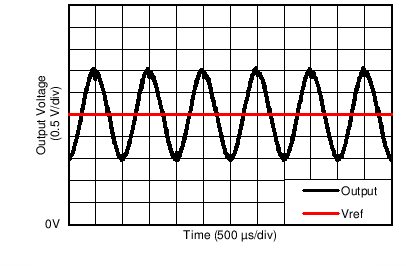ZHCSDE7A February 2015 – March 2021 INA225-Q1
PRODUCTION DATA
- 1 特性
- 2 应用
- 3 说明
- 4 Revision History
- 5 Pin Configuration and Functions
- 6 Specifications
- 7 Detailed Description
- 8 Applications and Implementation
- 9 Power Supply Recommendations
- 10Layout
- 11Device and Documentation Support
- 12Mechanical, Packaging, and Orderable Information
8.2.3.3 Application Curve
An example output response of a bidirectional configuration is shown in Figure 8-6. With the REF terminal connected to a reference voltage, 2.5 V in this case, the output voltage is biased upwards by this reference level. The output rises above the reference voltage for positive differential input signals and falls below the reference voltage for negative differential input signals.
 Figure 8-6 Bidirectional Application Output Response
Figure 8-6 Bidirectional Application Output Response